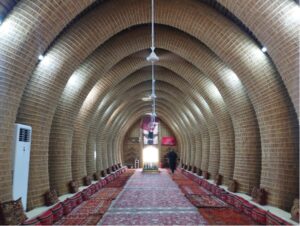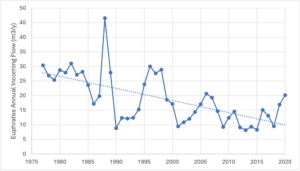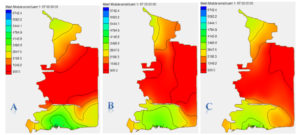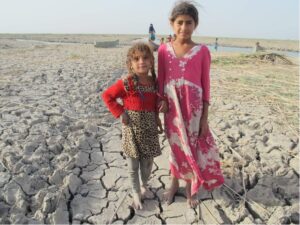The marshes of southern Iraq, once a vital ecological and cultural hub, have undergone dramatic transformations due to a combination of natural and human-induced factors. Harry Istepanian underscores the critical need for immediate and effective interventions to revive the marshes and mitigate the adverse impacts on the region’s ecosystems and communities of the two largest marshes in Iraq Al-Hammar and Al-Huweizah, which stand as a testament to the region’s rich ecological and cultural heritage facing unprecedented climatic challenges revealed by recent studies.
Iraq’s southern marshes, once vibrant and teeming with life, are now under severe threat from climate change, pollution, oil exploration, and upstream dam construction. The indigenous population, known for their unique culture of fishing, buffalo breeding, and reed house construction, is seeing their ancient way of life erode as the environment deteriorates. The prolonged drought and water scarcity from the riparian countries have turned lush wetlands into barren land, increasing the water salinity and harming the wildlife. This situation is forcing local farmers and buffalo breeders to migrate to urban areas in search of better living conditions.
The region, a UNESCO World Heritage Site, had previously suffered under policies that drained the wetlands in the early 1990s, following the 1991 uprising against the former regime. By 1992, large-scale draining projects were initiated, causing significant reductions in water coverage. Although partially restored, it now faces new threats from industrial pollution and oil fields. This pollution is contributing to severe health issues among the local population. Many efforts are being made by international organizations and NGOs to raise awareness and call for regional cooperation to address water scarcity issues. Environmental activists continue to fight for the marshes despite facing significant dangers, including threats and kidnapping. The struggle to preserve these wetlands is seen as crucial not just for the environment and economy but also for maintaining a unique cultural heritage.

Desertification: The Silent Threat to Southern Iraq’s Wetlands
In a comprehensive study titled “Desertification Assessment for the Marshes Region Using Soil Quality Indicators, Southern Iraq,” published in the Iraqi Geological Journal in 2023, the researchers have spotlighted a growing environmental crisis in southern Iraq’s marshlands Al-Hammar, Central Marshes, and Al-Hawizeh Marsh, The largest remnant marsh, spanning roughly 28,000 square kilometers (km2) across the Amarah, Basrah, and Nasiriyah governorates, are facing an escalating threat of desertification. Using advanced modeling techniques like MEDALUS, satellite imagery, and GIS technology, the researchers analyzed the soil quality and mapped out desertification sensitivity. The results are alarming: while only 3.52% (984 km²) of the area is classified as non-sensitive, a staggering 96.48% (27,005 km²) is marked as sensitive to desertification. The study concluded that water scarcity, salinity, wildfires, soil erosion, high temperature, and minimal rainfall (less than 25 mm per year), are exacerbating the daunting situation of the marshes with severe implications.
A study on climate change impact on the marshlands by the University of Baghdad published in 2024, concluded that Hawizeh Marsh, requires substantial water resources to restore 65 to 75% of its area, equating to 1,908 to 2,200 km2 annually, this restoration effort will require between 2.0 to 2.4 billion cubic meters (m3) of water, primarily sourced from Iran through the Karkah, al-Teeb, and Duwereg rivers. However, to meet this restoration target, the Tigris River must contribute 0.78 to 1.03 billion m3 of water each year. This amount represents 1.58 to 2.08% of the river’s current annual average inflow and could account for 1.96 to 2.58% of the projected future inflow of the Tigris River.
The Hammar Marsh, which spanned 1,750 km² in 1973, shrank to 400 km² in 2005 and partially recovered to 1,288.5 km² by 2019. According to the same study, restoring 55% (1,501 km²) to 75% (2,047 km²) of the Hammar Marsh will require an annual water discharge of 4.0 to 5.0 billion m3. This water is entirely sourced from the Euphrates River, which represents 14.15 to 17.69% of the river’s current annual average inflow. Projections indicate that these restoration efforts would require 33.78 to 42.23% of the Euphrates’ future inflow. These figures highlight the substantial water needs for the Hammar Marsh restoration, underscoring the challenges posed by diminishing water resources and the critical importance of sustainable water management in the region.

This significant water requirement underscores the environmental challenges faced in preserving and restoring the Hawizeh Marsh amidst growing concerns over water scarcity and regional water management disputes. High temperatures and increasing soil salinity have already led to a significant reduction in vegetation and water resources. Human activities such as dam construction on the Iranian side, improper agricultural practices, and oil drilling are further accelerating the region’s degradation.
Another study by the University of Baghdad published in 2022 on Chibayish central marshes, concluded that in the southern part of Iraq’s marshes, salt concentration has reached alarming levels, averaging 7,345 mg/l. This area is particularly affected by high salinity, significantly influenced by the discharges from feeder rivers and the topographical features of the marshland. Hydrodynamic and water quality models reveal that the Total Dissolved Solids (TDS) concentration in the marsh water is heavily impacted by the TDS levels of the incoming water and by evapotranspiration rates.

TDS of Chibayish central Marshes at various discharge rates (Reference)
Ecological Treasure Trove
For millennia, the marshes were acting as natural regulators of water flow in the southern parts of Iraq, maintaining soil moisture levels, and supporting agricultural activities. Seasonal changes have a significant impact on these wetlands, with water levels rising during floods and receding during dry periods. This dynamic hydrological system was essential for water purification, flood control, and a biodiversity hotspot providing a habitat for migratory birds and home to an array of plant and animal species, some of which are unique to the region.
The drought and water scarcity are now causing severe ecological damage, including the loss of biodiversity. The unique flora and fauna of the marshes are suffering tremendously and the wildlife is gradually vanishing, leading to the disappearance of many species.

Agriculture, fisheries, and livestock, which are the backbone of the local economy, are facing devastation due to rising of the water salinity, causing severe drinking water shortages in the marshes, forcing the locals to buy water from the nearby cities of Basra, Amarah, and Nasiriyah. Salinity is also causing the death of the livestock and forcing the locals to sell the livestock at low prices and abandon their ancestral homes. This displacement is leading to a gradual but significant loss of cultural and social heritage.

The Al-Hammar and Al-Huweizah marshes of southern Iraq are irreplaceable ecological and hydrological assets. Protecting and restoring these wetlands is not just an environmental necessity but also a socio-economic imperative, crucial for the well-being of local populations and the preservation of a unique cultural legacy. Immediate and concerted action is required to ensure that the marshes, once the heartbeat of southern Iraq, can continue to thrive for generations to come.
All photos are courtesy of Jassim AlAsadi © 2024.
Harry Istepanian is a PMP certified, independent Chartered Engineer (CEng.) with more than 30 years of experience in large-scale power and water utility and IWPP projects in developing countries, including SE Asia and MENA in addition to New Zealand and Australia.
![Iraq Climate Change Center [IC3+]](https://iraqclimatechange.org/wp-content/uploads/2024/06/logo2.png)

